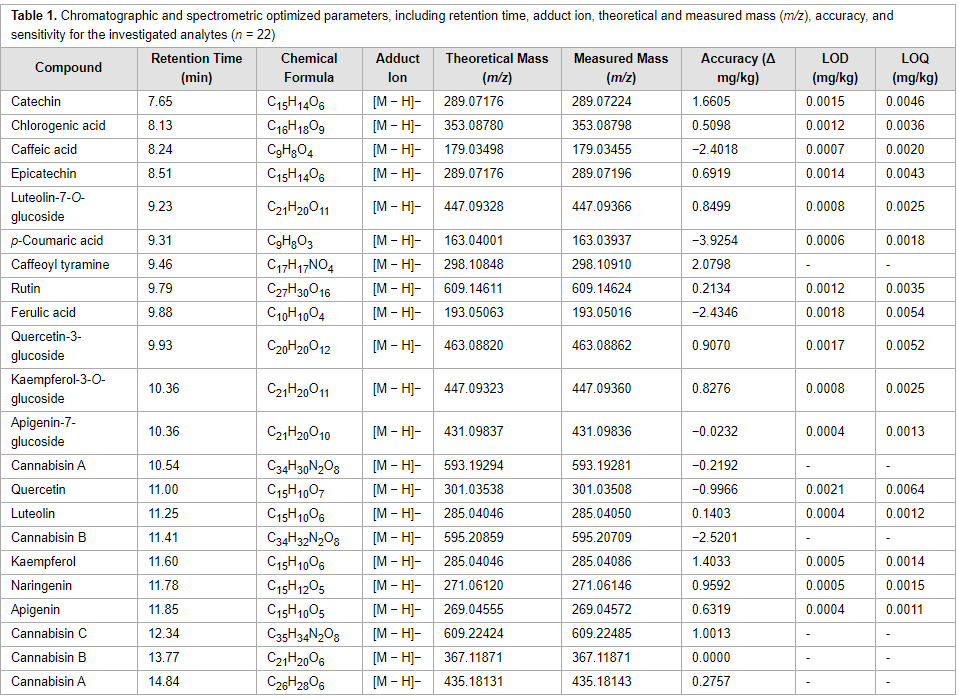Difference between revisions of "Template:Article of the month"
Shawndouglas (talk | contribs) (Updated for February) |
Shawndouglas (talk | contribs) (Updated for March) |
||
| Line 1: | Line 1: | ||
<div style="float: left; margin: 0.5em 0.9em 0.4em 0em;">[[File:IzzonAnalysisPhenolTab1Screen.png|240px]]</div> | <div style="float: left; margin: 0.5em 0.9em 0.4em 0em;">[[File:IzzonAnalysisPhenolTab1Screen.png|240px]]</div> | ||
'''"[[Journal: | '''"[[Journal:Methods for quantification of cannabinoids: A narrative review|Methods for quantification of cannabinoids: A narrative review]]"''' | ||
Around 144 [[Cannabinoid|cannabinoids]] have been identified in the ''[[Cannabis]]'' plant; among them [[tetrahydrocannabinol]] (THC) and [[cannabidiol]] (CBD) are the most prominent ones. Because of the legal restrictions on cannabis in many countries, it is difficult to obtain standards to use in research; nonetheless, it is important to develop a cannabinoid quantification technique, with practical pharmaceutical applications for quality control of future therapeutic cannabinoids. To find relevant articles for this narrative review paper, a combination of keywords such as "[[Cannabis (drug)|medicinal cannabis]]," "analytical," "quantification," and "cannabinoids" were searched for in PubMed, EMBASE, MEDLINE, Google Scholar, and Cochrane Library (Wiley) databases. The most common cannabinoid quantification techniques include [[gas chromatography]] (GC) and [[high-performance liquid chromatography]] (HPLC). Gas chromatography is often used in conjunction with [[mass spectrometry]] (MS) or [[Wikipedia:Flame ionization detector|flame ionization detection]] (FID).('''[[Journal:Methods for quantification of cannabinoids: A narrative review|Full article...]]''')<br /> | |||
<br /> | <br /> | ||
''Recently featured'': | ''Recently featured'': | ||
: ▪ [[Journal:Analysis of phenolic compounds in commercial Cannabis sativa L. inflorescences using UHPLC-Q-Orbitrap HRMS|Analysis of phenolic compounds in commercial Cannabis sativa L. inflorescences using UHPLC-Q-Orbitrap HRMS]] | |||
: ▪ [[Journal:Analysis of cannabidiol, delta-9-tetrahydrocannabinol, and their acids in CBD/hemp oil products|Analysis of cannabidiol, delta-9-tetrahydrocannabinol, and their acids in CBD/hemp oil products]] | : ▪ [[Journal:Analysis of cannabidiol, delta-9-tetrahydrocannabinol, and their acids in CBD/hemp oil products|Analysis of cannabidiol, delta-9-tetrahydrocannabinol, and their acids in CBD/hemp oil products]] | ||
: ▪ [[Journal:Screening for more than 1,000 pesticides and environmental contaminants in cannabis by GC/Q-TOF|Screening for more than 1,000 pesticides and environmental contaminants in cannabis by GC/Q-TOF]] | : ▪ [[Journal:Screening for more than 1,000 pesticides and environmental contaminants in cannabis by GC/Q-TOF|Screening for more than 1,000 pesticides and environmental contaminants in cannabis by GC/Q-TOF]] | ||
Revision as of 17:59, 28 February 2021
"Methods for quantification of cannabinoids: A narrative review"
Around 144 cannabinoids have been identified in the Cannabis plant; among them tetrahydrocannabinol (THC) and cannabidiol (CBD) are the most prominent ones. Because of the legal restrictions on cannabis in many countries, it is difficult to obtain standards to use in research; nonetheless, it is important to develop a cannabinoid quantification technique, with practical pharmaceutical applications for quality control of future therapeutic cannabinoids. To find relevant articles for this narrative review paper, a combination of keywords such as "medicinal cannabis," "analytical," "quantification," and "cannabinoids" were searched for in PubMed, EMBASE, MEDLINE, Google Scholar, and Cochrane Library (Wiley) databases. The most common cannabinoid quantification techniques include gas chromatography (GC) and high-performance liquid chromatography (HPLC). Gas chromatography is often used in conjunction with mass spectrometry (MS) or flame ionization detection (FID).(Full article...)
Recently featured:
- ▪ Analysis of phenolic compounds in commercial Cannabis sativa L. inflorescences using UHPLC-Q-Orbitrap HRMS
- ▪ Analysis of cannabidiol, delta-9-tetrahydrocannabinol, and their acids in CBD/hemp oil products
- ▪ Screening for more than 1,000 pesticides and environmental contaminants in cannabis by GC/Q-TOF
